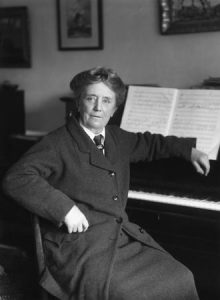 For the second time in three years, a composition by Dame Ethel Smyth was performed by the first-rate Chamber Music group Chameleon in Ft. Lauderdale.
For the second time in three years, a composition by Dame Ethel Smyth was performed by the first-rate Chamber Music group Chameleon in Ft. Lauderdale.
Her Sonata for Cello and Piano dates from 1887, long before she was made a Dame Commander of the Order of the British Empire in 1922. Although little known now, she was a major composer in British music for more than four decades.
Smyth was also a leader in the women’s movement. She famously fell in love with a series of notable women, including the French Empress Eugenie, and the English writer Virginia Woolf. There is a statue of the leader for women’s voting rights, Emmeline Pankhurst, in the gardens of Parliament in London. When it was unveiled in 1930, Smyth conducted the band which played The March of Women. She is a pictured here at right.
Two years ago Chameleon, led by cellist Iris van Eck, played a Quintet by Smyth. My report on that performance can be read at this link in Sun News Miami: http://www.sunnewsmiami.com/miami-news/item/601-music-and-art-for-women-s-day
On March 18 this year Iris and pianist Kemal Gekic performed the Sonata at the Broward Center for the Performing Arts. It was only the second performance at this venue, which has superior acoustics to the previous location at the Opera Center.
 The Sonata begins with a movement marked Allegro moderato. It is intensely thoughtful but free of pathos. The mood darkens, however, in the second movement, Adagio non troppo, which features a long brooding passage. The third movement, Allegro vivace e grazioso, delights with a tarantella that has no obvious connection with the previous two movements. Here the piano assumes a much more forceful role, at one point mimicking the plucking strings of the cello.
The Sonata begins with a movement marked Allegro moderato. It is intensely thoughtful but free of pathos. The mood darkens, however, in the second movement, Adagio non troppo, which features a long brooding passage. The third movement, Allegro vivace e grazioso, delights with a tarantella that has no obvious connection with the previous two movements. Here the piano assumes a much more forceful role, at one point mimicking the plucking strings of the cello.
In an interview, Van Eck said she regards this Sonata as a romantic piece, but one with an odd rhythm. “It is a very interesting rhythm. In rehearsal we were off beat, but it is supposed to be that way. There is just not a downbeat, which makes it a floaty kind of feeling,” she explained. There is also a second Sonata by Smyth, she told me, but it is still not published. Van Eyck hopes to perform that rare piece in the future.
Also included in the concert was the well-known Sonata in D by Johann Sebastian Bach. To my mind the second movement evoked a coach ride by a couple to a grand country estate, while the third portrayed their stroll through its formal garden. A visit to a folly on the grounds induced a contemplative passage with the cello seeming to pose a question that was answered by the piano. One wonders what they were discussing! The final movement was a lovely capriccio, evoking the chatter and gossip of the country houses guests after a fine dinner.
Also on the programme was El Andalus, a 2004 composition by Katherine Hoover that is notable for several dark passages, one of which elicits a quivering response of uncertainty from the cello. Concluding the concert was the great Sonata for cello and piano by Prokofiev, dating from 1950. It opens with a cello solo that features a plaintive yet voluptuous melody that, with some trepidation, explores a landscape of musical possibilities.
It’s second movement, Moderato, features a playful step-like interaction between the two instruments, as if they were trying out a new dance move. The concluding Allegro relies heavily on the plucking of the cello strings. Strong chords from the piano elicit a complex response from the cello, making this composition – one of Prokofiev’s final three before his death in 1953 – an audience favourite.
For more on Chameleon, send an email: Chameleon@gsta.net
Photo of Van Eck and Gekic by C. Cunningham, copyright Sun News Austin
